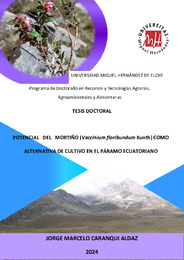Please use this identifier to cite or link to this item:
https://hdl.handle.net/11000/35717Full metadata record
| DC Field | Value | Language |
|---|---|---|
| dc.contributor.advisor | Martínez Font, Rafael | - |
| dc.contributor.advisor | Hernández, Francisca | - |
| dc.contributor.author | Caranqui Aldaz , Jorge Marcelo | - |
| dc.contributor.other | Departamentos de la UMH::Producción Vegetal y Microbiología | es_ES |
| dc.date.accessioned | 2025-02-24T12:18:56Z | - |
| dc.date.available | 2025-02-24T12:18:56Z | - |
| dc.date.created | 2024-10-30 | - |
| dc.identifier.uri | https://hdl.handle.net/11000/35717 | - |
| dc.description | Programa de Doctorado en Recursos y Tecnologías Agrarias, Agroambientales y Alimentarias | es_ES |
| dc.description.abstract | Los páramos forman parte de una notable biodiversidad a escala de ecosistemas que se presentan en el Ecuador. El mortiño (Vaccinium floribundum Kunth), de la familia Ericaceae, es una especie nativa de los páramos ecuatorianos con hábito arbustivo y frutos comestibles. Las poblaciones han sufrido procesos de pérdida por deforestación, reconversión productiva, fragmentación, perturbación por su extracción, por lo que es necesario: (1) Realizar una concienzuda revisión bibliográfica sobre el “estado del arte” del mortiño; demostrando su importancia agroalimentaria y potencial contribución a la mejora de los entornos socioeconómicos deprimidos; (2) Caracterizar fenológicamente el material vegetal seleccionado mediante fenogramas de cada una de las distintas etapas del desarrollo reproductivo anual del mortiño y, (3) Caracterización bioquímica del material vegetal, resaltando las propiedades, principios activos y otros beneficios de los frutos del mortiño | es_ES |
| dc.description.abstract | The páramos are part of a notable biodiversity at the ecosystem level that occurs in Ecuador. The mortiño (Vaccinium floribundum Kunth), from the Ericaceae family, is a native species of the Ecuadorian páramos with a shrub-like growth habit and edible fruits. Its populations have suffered losses due to deforestation, productive conversion, fragmentation, and disturbances from extraction. Therefore, it is necessary to: (1) Carry out a thorough literature review on the "state of the art" of mortiño, demonstrating its agri-food importance and potential contribution to the improvement of depressed socioeconomic environments; (2) Phenologically characterize the selected plant material through annual phenograms of the different development reproductive stages of mortiño; and (3) Biochemical characterization of the plant material, highlighting the properties, active principles, and other benefits of mortiño fruits | es_ES |
| dc.format | application/pdf | es_ES |
| dc.format.extent | 93 | es_ES |
| dc.language.iso | spa | es_ES |
| dc.publisher | Universidad Miguel Hernández | es_ES |
| dc.rights | info:eu-repo/semantics/openAccess | es_ES |
| dc.rights | Attribution-NonCommercial-NoDerivatives 4.0 Internacional | * |
| dc.rights.uri | http://creativecommons.org/licenses/by-nc-nd/4.0/ | * |
| dc.subject | Mortiño | es_ES |
| dc.subject | Páramos ecuatorianos | es_ES |
| dc.title | Potencial del mortiño (Vaccinium floribundum kunth) como alternativa de cultivo en el páramo ecuatoriano | es_ES |
| dc.type | info:eu-repo/semantics/doctoralThesis | es_ES |

View/Open:
Tesis SF JORGE CARANQUI ALDAZ_compressed.pdf
1,77 MB
Adobe PDF
Share:
.png)
